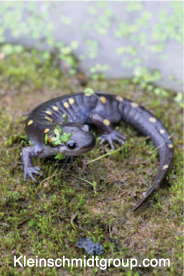Tess Howard, Undergraduate Research Assistant
Habitat fragmentation can have a large impact on the genetic diversity of vernal pools and the survival of their populations. Human activities, as well as natural features such as rivers and streams, can cause habitat fragmentation and lead to negative outcomes for of vernal pools amphibians, including wood frogs and spotted salamanders. Vernal pool amphibians function as a metapopulation, groups of smaller, inter-dependent subpopulations. Amphibians are able to travel between pools and spread their genes to increase genetic diversity, which helps create stable populations in vernal pools. Additionally, metapopulations usually rely on maintaining a high degree of sub-population connectivity so if one pool loses all of its inhabitants, it can be recolonized by individuals from another vernal pool, which ultimately improves the resilience of the whole metapopulation.
 This summer, I am beginning an undergraduate research project that will quantify the effects of habitat fragmentation on movement of wood frogs and spotted salamanders, two of Maine’s vernal pool-breeding amphibian species. I will be measuring the differences in population genetic diversity and gene flow between populations that are separated by human-made or natural barriers. This will be used to evaluate whether these landscape features differ in their ability to restrict movement of individuals among vernal pools. My project will look at both gene flow and genetic diversity by comparing how they differ between populations separated by human-made and natural barriers.
This summer, I am beginning an undergraduate research project that will quantify the effects of habitat fragmentation on movement of wood frogs and spotted salamanders, two of Maine’s vernal pool-breeding amphibian species. I will be measuring the differences in population genetic diversity and gene flow between populations that are separated by human-made or natural barriers. This will be used to evaluate whether these landscape features differ in their ability to restrict movement of individuals among vernal pools. My project will look at both gene flow and genetic diversity by comparing how they differ between populations separated by human-made and natural barriers.
This project is important to Maine because it will help us understand the effects that human-made barriers are having on native vernal pool amphibian populations. One way this knowledge could be implemented is through improvements in urban planning. Understanding which human-made landscape features act as barriers may affect how an urban planner will configure future development. For example, if roads or buildings are found to act as barriers to amphibian movement, urban planners can preserve travel paths between pools in order to preserve connectivity, and reduce the likelihood of inbreeding and population destabilization.

